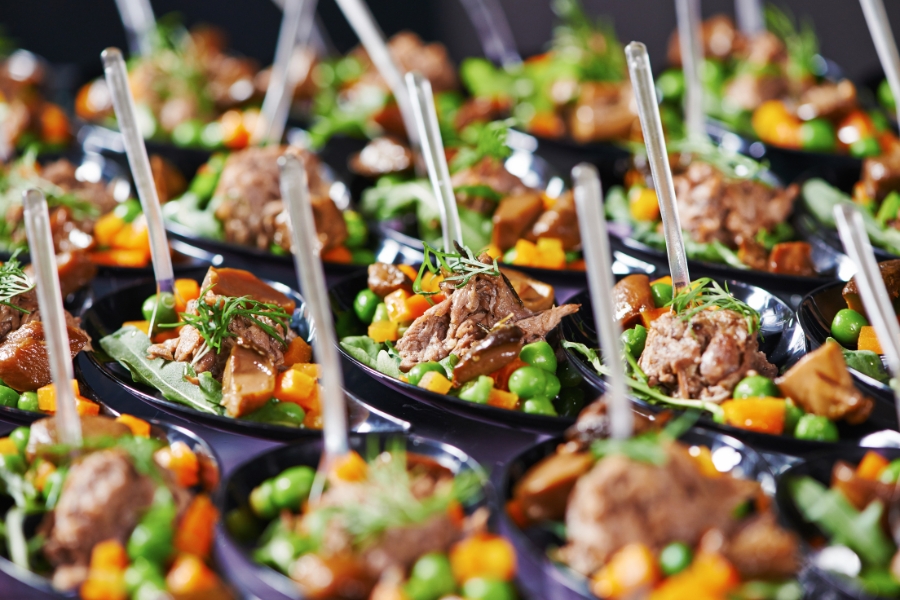
When planning an event, whether it’s an intimate gathering or a grand celebration, catering is often one of the biggest expenses. It’s the backbone of the experience—nourishing your guests while leaving them with a lasting impression of your event. However, budgeting for catering can feel like navigating a maze, especially if you’re unfamiliar with how costs are structured, what impacts pricing, and where you can save without cutting corners. Let’s dive into the details to help you plan a catering budget that balances quality and affordability.
Understanding Catering Costs: Breaking Down the Structure
Catering costs are composed of several distinct components. Understanding these will give you insight into what you’re paying for and help you make informed decisions about where to allocate your resources.
Food Costs
The food itself is the most significant portion of your catering budget, typically calculated on a per-person basis. The price per plate depends on several factors, including the complexity of the menu, the quality of ingredients, and the type of service (e.g., plated meal, buffet, or food stations). A simple buffet with standard options will cost less than an elegant, multi-course plated dinner featuring premium dishes like filet mignon or lobster.
Service Fees
Catering service fees cover the labor involved in your event. This includes chefs, kitchen staff, servers, bartenders, and support staff who ensure the event runs smoothly. The more hands-on the service—such as a plated dinner with multiple courses—the higher the associated service fees.
Rentals and Equipment
If your venue doesn’t provide essentials like tables, chairs, linens, and glassware, your caterer will often handle these rentals. Specialty items like custom table settings, themed decorations, or unique serving displays may come at an additional cost. Mobile cooking equipment or serving stations, such as portable pizza ovens or carving tables, will also increase expenses.
Setup and Cleanup
The unseen magic of catering lies in the setup and teardown. Caterers often charge for the time and labor required to set up food stations, arrange seating, and clean the space afterward. These services save you time and effort but are an essential part of the budget.
Taxes and Gratuities
It’s easy to overlook taxes and gratuities, but they can add a substantial amount to your bill. Most caterers include service charges or suggest tipping as a percentage of the total cost, so it’s crucial to factor these into your budget.
Understanding these categories helps you identify where your money is going and ensures you can budget effectively for a successful event.
What Drives Catering Costs Up?
Certain factors can significantly inflate your catering budget, and being aware of these will allow you to anticipate and manage costs.
Guest Count
The more guests you have, the higher the overall cost. Each additional person increases food, drink, and staffing requirements, which can quickly add up. Keep a firm guest list and avoid last-minute additions to stay within budget.
Menu Complexity
Sophisticated menus with intricate dishes and premium ingredients come at a premium. For example, offering sushi rolls, imported cheeses, or grass-fed meats will cost more than simpler, comfort-food options.
Beverages
An open bar stocked with top-shelf liquors is one of the fastest ways to inflate a catering budget. Alcoholic beverages can significantly impact costs, especially if the event includes custom cocktails or wine pairings. Even non-alcoholic options, like mocktail bars or specialty coffee stations, can add extra fees.
Service Style
The style of service directly impacts the catering budget. A buffet or food station typically requires fewer staff, whereas a plated dinner or family-style service needs a larger team to ensure smooth execution.
Venue Logistics
If your venue lacks a kitchen or has limited facilities, caterers may need to bring additional equipment, which increases costs. Similarly, remote or hard-to-reach venues often come with higher transportation fees.
Last-Minute Changes
Adjusting your guest count, menu, or setup close to the event date can lead to rush fees or additional charges. Planning ahead and confirming details early can help you avoid these costs.
Understanding these budget drivers allows you to prioritize what matters most while staying mindful of expenses.
Smart Ways to Save Without Sacrificing Quality
Catering is undoubtedly an investment, but there are savvy ways to save money while still delivering a memorable dining experience for your guests.
Use Seasonal and Local Ingredients
Seasonal produce and locally sourced ingredients are often more affordable and fresher than imported or out-of-season items. They also enhance the quality and flavor of the dishes while showcasing regional cuisine.
Simplify the Menu
Instead of offering an extensive array of options, focus on a smaller, curated menu of standout dishes. A concise menu can still impress guests while being more cost-effective.
Limit Alcohol Options
Alcohol can be a major expense, so consider offering a limited selection of wines, beers, and one or two signature cocktails instead of a full open bar. Alternatively, host a cash bar where guests can purchase additional drinks if desired.
Choose Cost-Effective Service Styles
Buffets and food stations are generally more budget-friendly than plated meals, as they require fewer staff. These options also offer flexibility and variety, catering to different tastes and dietary preferences.
Reuse Décor Elements
If your caterer provides decorative serving trays, centerpieces, or food displays, coordinate with your event planner to incorporate these into the overall theme. This reduces the need for additional decor.
Be Transparent About Your Budget
Communicate your budget clearly to your caterer from the start. Many caterers are happy to work within financial constraints and can suggest creative ways to save without sacrificing quality or presentation.
These strategies ensure you get the most value from your catering investment without compromising the guest experience.
How to Plan Your Catering Budget
Creating a well-thought-out catering budget requires careful planning. Here’s a step-by-step approach to help you manage your expenses:
Determine Your Total Event Budget: Decide how much you’re willing to spend on the entire event and allocate a percentage (usually 30–50%) to catering.
Estimate Your Guest Count: This is a critical factor in determining food, beverage, and staffing costs. Keep track of RSVPs to avoid over- or underestimating.
Prioritize Must-Haves: Identify the elements most important to you, such as a signature dish, a themed cocktail, or specific service styles, and allocate more of your budget to these priorities.
Request Multiple Quotes: Compare pricing and services from several caterers to find the best fit for your needs and budget.
Review the Contract Carefully: Ensure the quote includes all services, such as rentals, setup, and gratuities, and ask questions about any unclear charges.
These steps provide a clear framework for managing your catering budget and ensuring a successful event.
Conclusion: Delicious Experiences Within Your Means
Catering is one of the most memorable aspects of any event, and it deserves thoughtful planning and budgeting. By understanding how catering costs are structured, anticipating what drives expenses, and employing smart cost-saving strategies, you can create a dining experience that delights your guests without breaking the bank. Open communication with your caterer and a focus on your priorities will help you balance quality and affordability, making your event as enjoyable as it is memorable.
